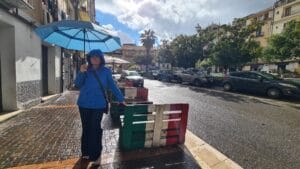
Lamezia Terme: The Blog That Nearly Didn’t Happen – By Andy
A2Z Wander | Our Blog A Rainy Arrival (and a Slight Hangover) Lamezia Terme almost didn’t get its own blog post. There’s only so many

23.42 pm the night before we head to Florence: I lie awake with anxiety. Earlier that evening, we were told of a strike by train operating staff, which may affect us getting to our one day in Florence. We were warned about Italian trains before our trip, but thus far, nothing has gone wrong. I guess we were due some bad luck.
5.45 am: Wake up ahead of the alarm. Check trains. Something is running, we might be ok.
6.00 am: Alarm goes off. The earlier train has a delay but is running, according to their online system at least. Fingers crossed.
6.30 am: I check the train again. It left Viareggio on time, we’re going to Florence!
7.00 am: Open our doors to find our wonderful host, despite our early start, has left us a flask of coffee and pastries. The best host!

Florence is the most populated city in Tuscany. A million people call this regional capital home, and a further c.15 million visitors flood in every year.
Considered by many to be the birthplace of the Renaissance, Florence was one of the wealthiest cities of medieval Europe. A centre for trade and finance, it wielded enormous influence in Italy, Europe, and beyond.
Its turbulent history includes periods of rule by the powerful Medici family and numerous religious and republican revolutions, and from 1865 to 1871 the city served as the capital of the Kingdom of Italy. The Florentine dialect forms the base of standard Italian, and it became the language of culture throughout Italy.
UNESCO declared the Historic Centre of Florence a World Heritage Site in 1982, and it’s consistently ranked as one of the most beautiful cities in the world, noted for its culture, art and architecture.
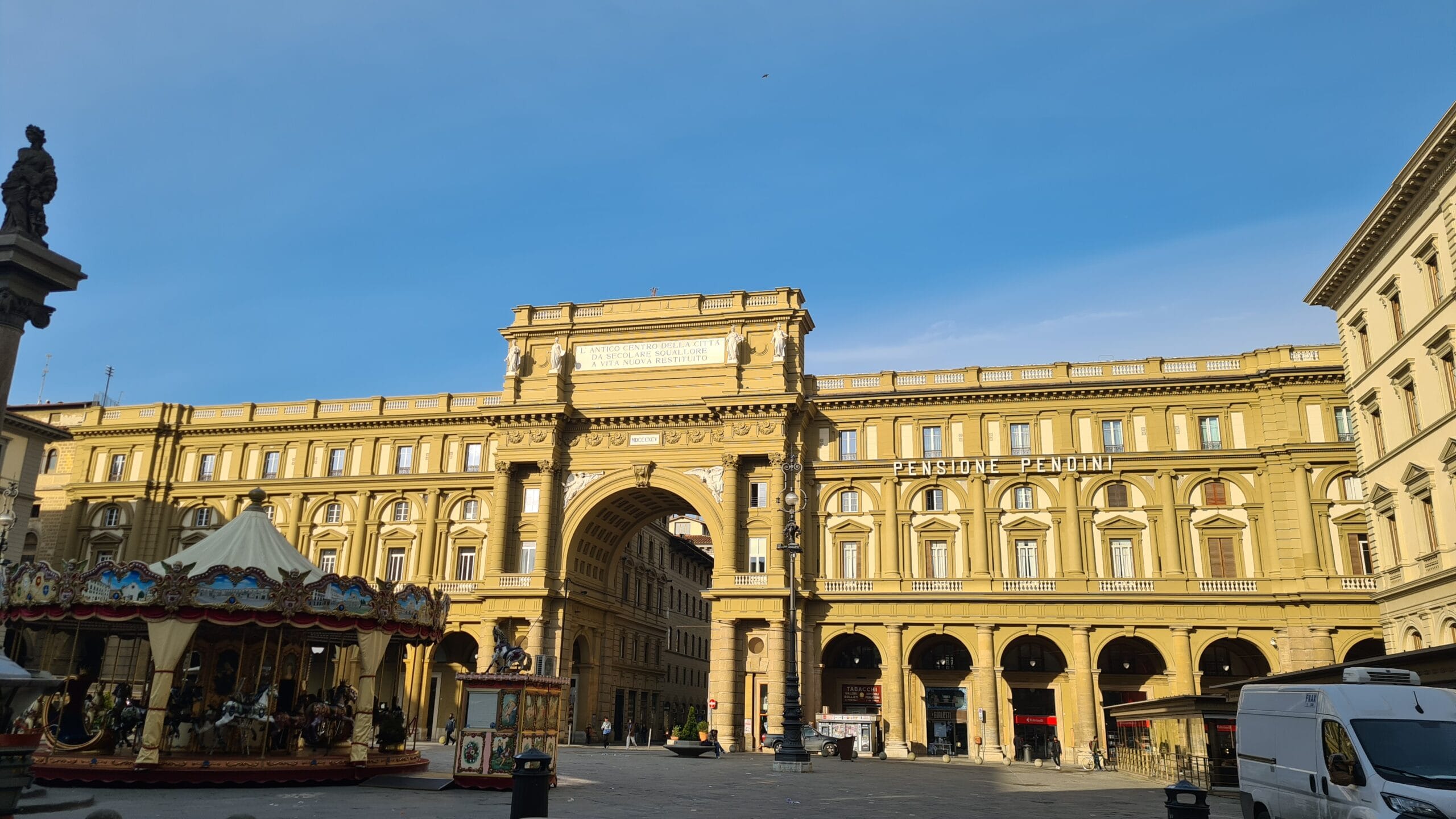
The numerous museums and art galleries are home to works of renowned artists – di Cambio, Giotto, di Banco, Ghiberti, Lippi, Raphael, Donatello, Botticelli, Leonardo da Vinci and of course Michelangelo and his David, to name but a few.
So, can Florence be done in a day?
No, obviously not. There’s far too much to this city to be able to do it justice in a day. Something we knew before our visit.
In fact, we thought we might skip Florence completely because this trip is about more than just the obvious tourist destinations. However, places gain a reputation and visitors for a reason, and their draw is hard to ignore.
Staying in Prato, a short train ride to Florence, we decided that despite having only a day to spare we’d make the most of it.
We had to pick one of the main two galleries. With only one day and with a lot more to fit in, a decision had to be made.
The Uffizi houses the premier collection of Italian Renaissance art, featuring works by masters such as Botticelli, Titian, Michelangelo and da Vinci. Galleria dell’Accademia has the iconic Michelangelo’s David. It’s a tough call. Going to Florence and not seeing David is like skipping the Mona Lisa in Paris. But not going to the Uffizi is like not visiting the Eiffel Tower?!
After some deliberation, Zoe having left the decision in my capable hands, and not a coin toss in sight, I decided on… The Uffizi. The building itself, housing many great examples of renaissance art, is gloriously grand and probably just tipped the decision in its favour.
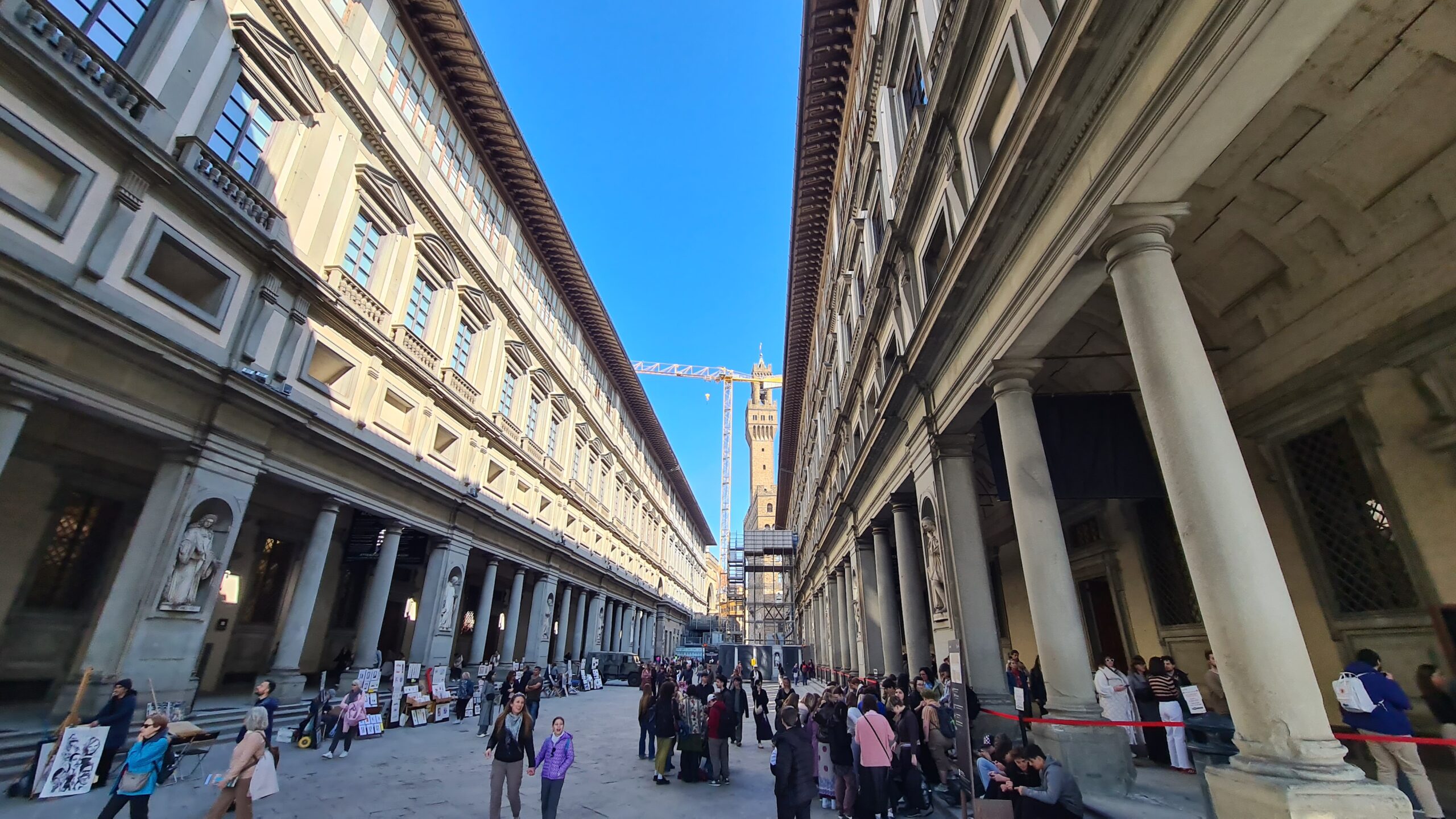
For the major attractions it is, of course, always worth pre-booking. During this process we discovered that for International Women’s Day, Zoe was getting in for free. What a lovely gesture by the museum and a bonus for our budget.

It’s a busy attraction, in fact the most visited art gallery in Italy and 5th most visited in the world, with around 5 million visitors annually. We got there for the second slot at 8.45 am. The timed entry means the first part of the visit can be a bit hectic, swarms of people all trying to see the same artworks, but we found it thinned out as people found their own pace.

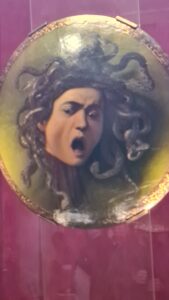 The Uffizi houses a priceless collection of artworks, with a particular focus on the Italian Renaissance. When the powerful House of Medici came to an end, their vast art collection was gifted to the city of Florence by Anna Maria Luisa, the last Medici heiress. The Uffizi is considered one of the world’s first modern museums. While it had welcomed visitors informally since the sixteenth century, it was officially opened to the public in 1769.
The Uffizi houses a priceless collection of artworks, with a particular focus on the Italian Renaissance. When the powerful House of Medici came to an end, their vast art collection was gifted to the city of Florence by Anna Maria Luisa, the last Medici heiress. The Uffizi is considered one of the world’s first modern museums. While it had welcomed visitors informally since the sixteenth century, it was officially opened to the public in 1769.
From the Uffizi’s website “…the Uffizi is a parade of intellect, a gallery of wonders, a compendium of absolute masterpieces from western painting, set out in chronological order, from the 13th to the 18th centuries, with the addition of an archaeological collection of ancient Greek and Roman sculptures.”
If you’re interested in seeing masterpieces by some of the most important artists in Italian—and indeed world—history, then it’s well worth a visit. That said, it may not be to everyone’s taste; much of the collection is made up of religious artwork and iconography. If that’s not your thing, one of Florence’s many other museums might be a better fit.

Even if religious themes aren’t usually your thing, the Uffizi offers moments of real awe. Some works are so vast you can’t imagine where an artist even began, while sculptures have such lifelike detail they seem poised to move. And beyond the art itself, the museum is a masterpiece—an extraordinary space to walk through, even if it stood empty.
A choice, well made.

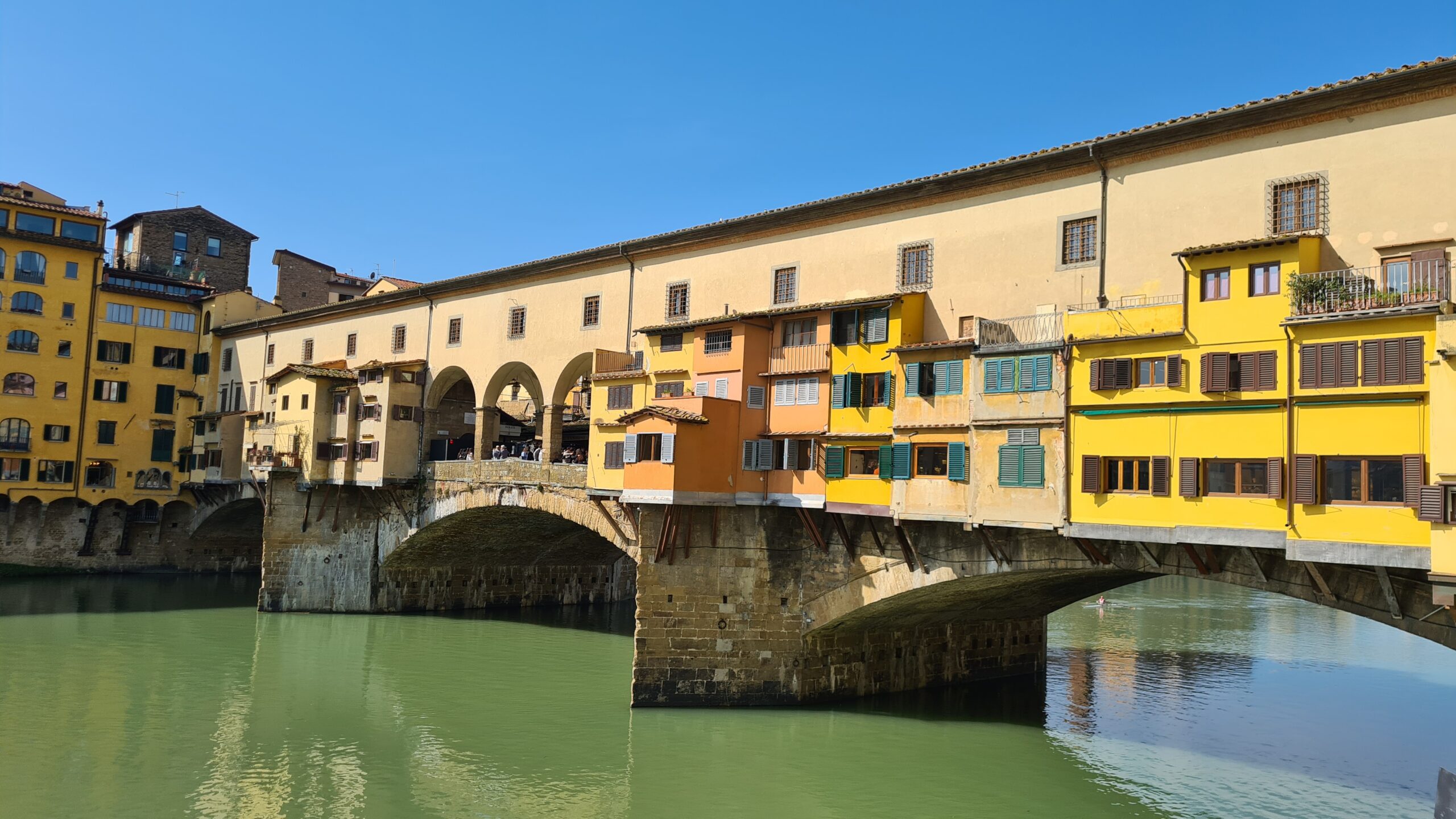
The oldest bridge in the city and an icon of Florence. The bridge is an “inhabited bridge” home to goldsmiths and jewellers, although this was not always the case. The current bridge dates back to around 1339 and previously housed butchers until 1594 when Ferdinando I de’ Medici passed a decree because he didn’t like the odour of meat drifting up into the Vasari corridor as he passed from his residence Palazzo Pitti to his offices in Palazzo Vecchio.
The bridge houses this corridor, which you can enter from the Uffizi gallery with a booking. If you look closely, the corridor deviates around a tower, the Mannelli Tower. Owned by another powerful family, they defied the demolition order from the Medici’s and so the corridor diverts around the tower!

As you cross the bridge with the hoards of other tourists, it’s hard not to imagine times gone by when this was not so much a tourist trap but a place where the sound of bartering took over, or even the odour of a Florentine steak filled the air.
We’re fortunate to be able to experience this bridge, it’s the only bridge in Florence to survive World War Two!

From Ponte Vecchio we headed to Piazza de Pitti, home of Palazzo Pitti. With limited time however, we had already decided this attraction and the famous gardens would have to wait for another day. But from the piazza the grandeur of the home of the Medicis and later a royal residence of the Savoys is an incredible sight. It is no wonder the building was originally built by a banker, Luca Pitti, you can imagine it takes extremely deep pockets to construct something of this scale.
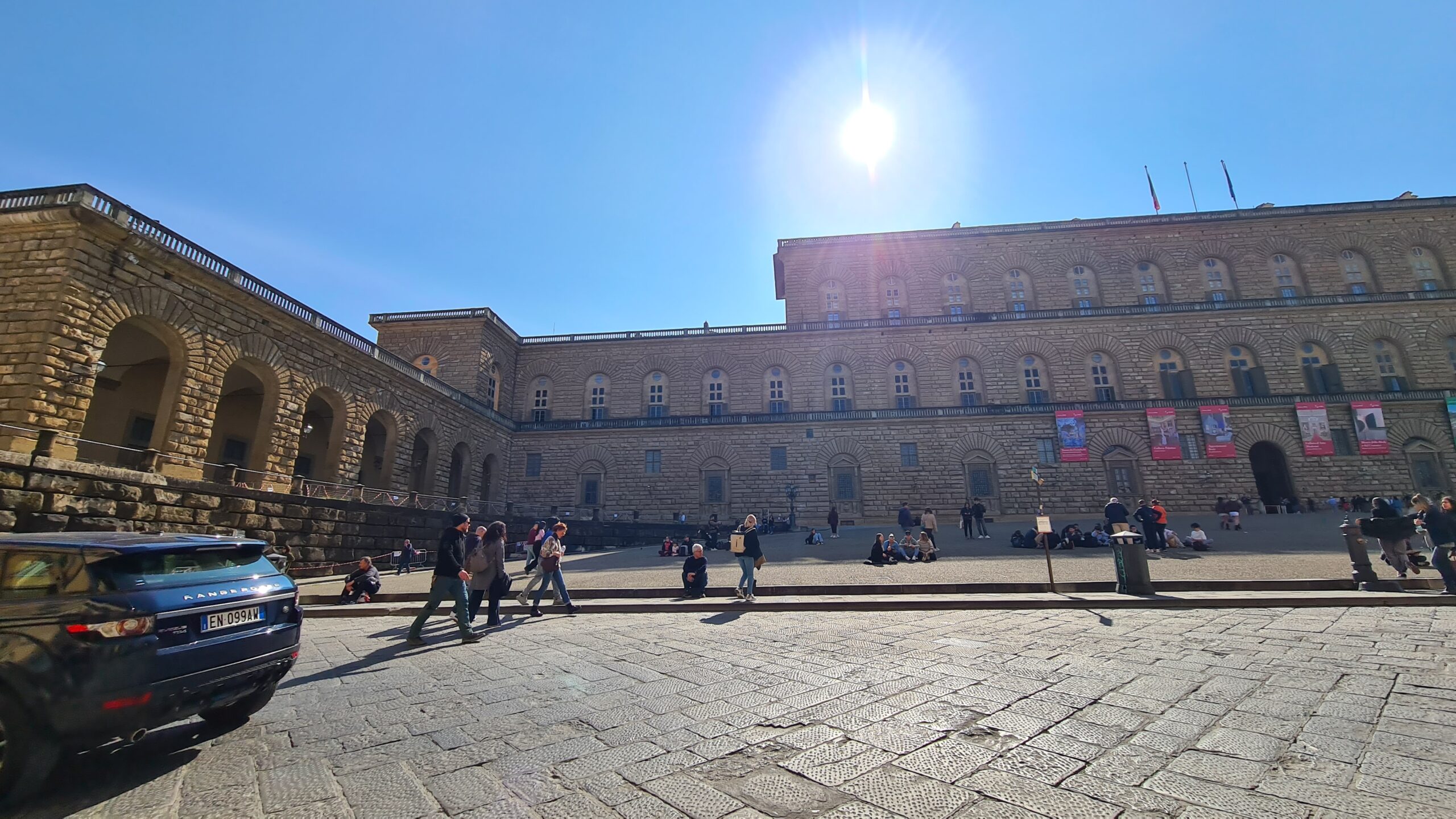
This grand church sits in a piazza of the same name. While grand, it was not as ornate as others we had and were to visit. Another difference was that this church appeared to enforce a strict no photos policy. So you won’t see any photos in our gallery.
On the left of the church for 2 euros you can see Michaelangelo’s Crucifix, a sculpture of Christ on the crucifix carved by a 17 year old Michaelangelo as a gift for being able to anatomically study the corpses coming from the convent’s hospital.
The crucifix is eerily suspended by a single wire in the middle of a large octagonal room. I wish I was able to take a photo, as I entered the room the light shone through a window at the top of the octagon directly onto the carving of christ. The rest of the room lay in relative darkness. It was a haunting powerful image. If I was in any way inclined to take signs, I may have taken it, but as a hardened atheist I just appreciated the visual power of what I was seeing.
If you wish to see images, you can do so here.
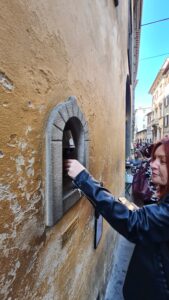 Stanley Tucci has a lot to answer for. The next item on our agenda was to find a wine window. In his excellent (Well, we loved it! And perhaps a little inspiration for this leg of our trip) series “Stanley Tucci: Searching for Italy” he visits Florence and one of their wine windows.
Stanley Tucci has a lot to answer for. The next item on our agenda was to find a wine window. In his excellent (Well, we loved it! And perhaps a little inspiration for this leg of our trip) series “Stanley Tucci: Searching for Italy” he visits Florence and one of their wine windows.
These small doored “windows” have been around since the 16th century. Cosimo de Medici permitted local wine growers who owned vineyards throughout the region to sell their wine through these small windows, avoiding paying taxes because it wasn’t a shop.
Today, a couple of hundred of these windows have survived and can be seen around the city.

There are some useful blogs listing the areas of the city where you’re most likely to see them and even one with a map of specific wine window locations. There’s not many still in actual operation so we head to the same one as Stanley, attached to a bar/restaurant called Babae.
As we arrive there’s a big group, clearly on some kind of wine tour huddled around the window stopping anyone else from getting anywhere near. Not wanting to be rude and interrupt their fun, we hold off barging through them long enough to realise they’ll soon be on their way.
Sure enough a window of time opens for our wine window time. The group jovially wander off to their next stop, and we have the window to ourselves. We’re quick to snap photos and selfies, we ring the bell and order. The wine is not the cheapest or finest you’ll ever drink, but what do you expect for the novelty and experience. There’s even an offer to buy the branded glasses we’re given the wine in, not that we’d recommend that, they’re plastic for a start but if you’re after a souvenir you could do worse I suppose.

We also found quite a number of the defunct wine windows. Once you see one, you see them everywhere. It’s a fun game to play when wandering the streets (hint: usually they’re found next to a large door).

One of Zoe’s favourite pastimes for places that we visit is to look up all the rooftop bars/restaurants and ensure we know exactly where to find a good view. With our appetite whetted by the wine, we go in search of one. This particular rooftop is not close to where we are, in fact it’s virtually the other side of the city, but we figure by the time we walk there we’ll have earnt our lunch.
We pass the very impressive Basilica di Santa Maria Novella, a 15th-century Dominican church including famous frescoes by Gothic & early Renaissance masters, another for another day.
While walking, with me navigating, Zoe has a habit of stopping behind me, leaving me talking to myself until I realise I’m companionless. Sometimes it’s for a photo opportunity, sometimes because of a cute animal, but in this instance a shop has taken her eye. An artisanal farm shop, Il Palagiaccio, whose philosophy is “quality is not a luxury”. And we agree, quality certainly shouldn’t be a luxury, but back home in the UK all too often it is.
One thing our travels always reinforce is that the quality of basic food in places like Italy and Spain is far superior to what we get and you don’t have to pay through the nose to eat well. And we’re about to eat very well.
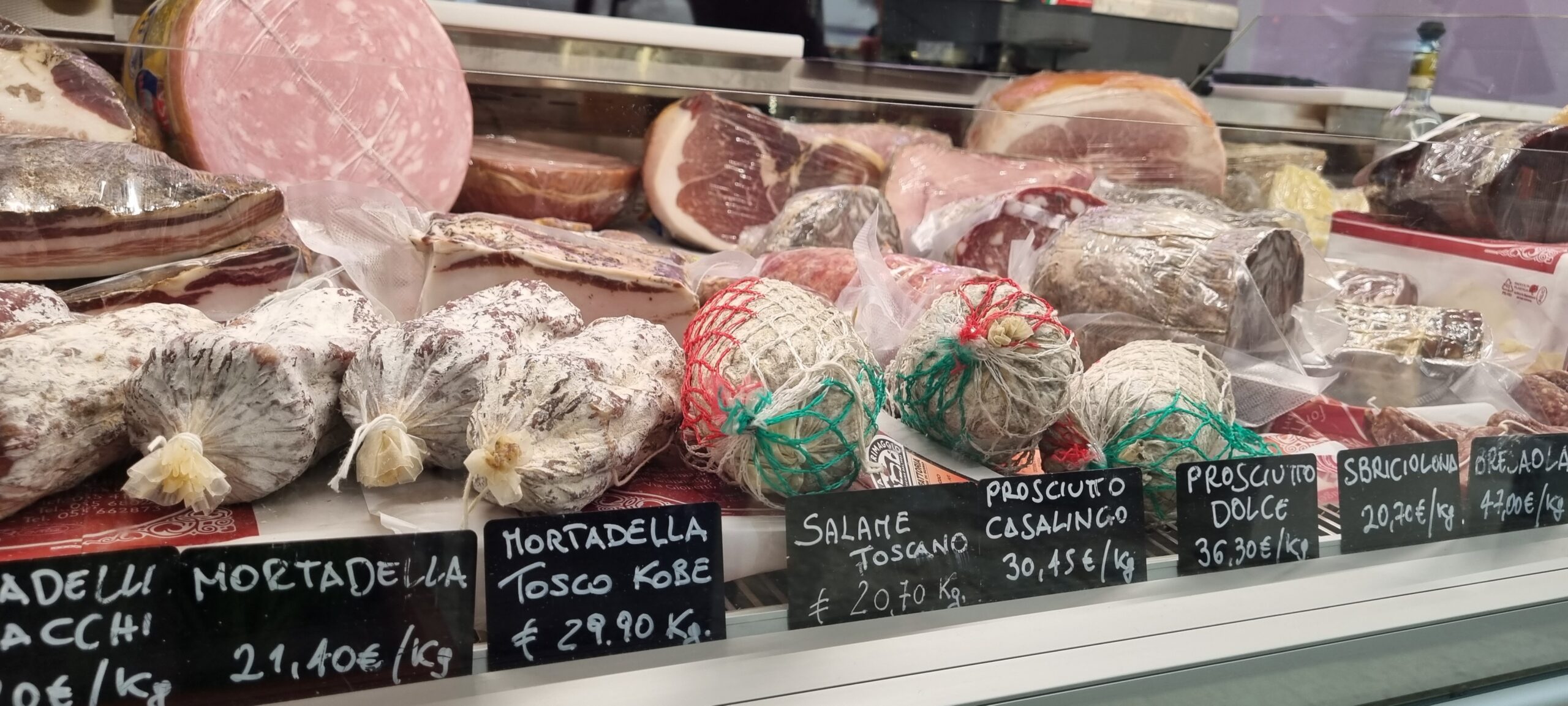
Il Palagiaccio has 5 shops in Florence, but to our luck we happen to walk into the charming GIampiero’s. Friendly from the outset, Giampiero entices us to stop and try the sharing board with some local wine. We’re not disappointed. The produce is outstanding, cheese, meats and bread equally.
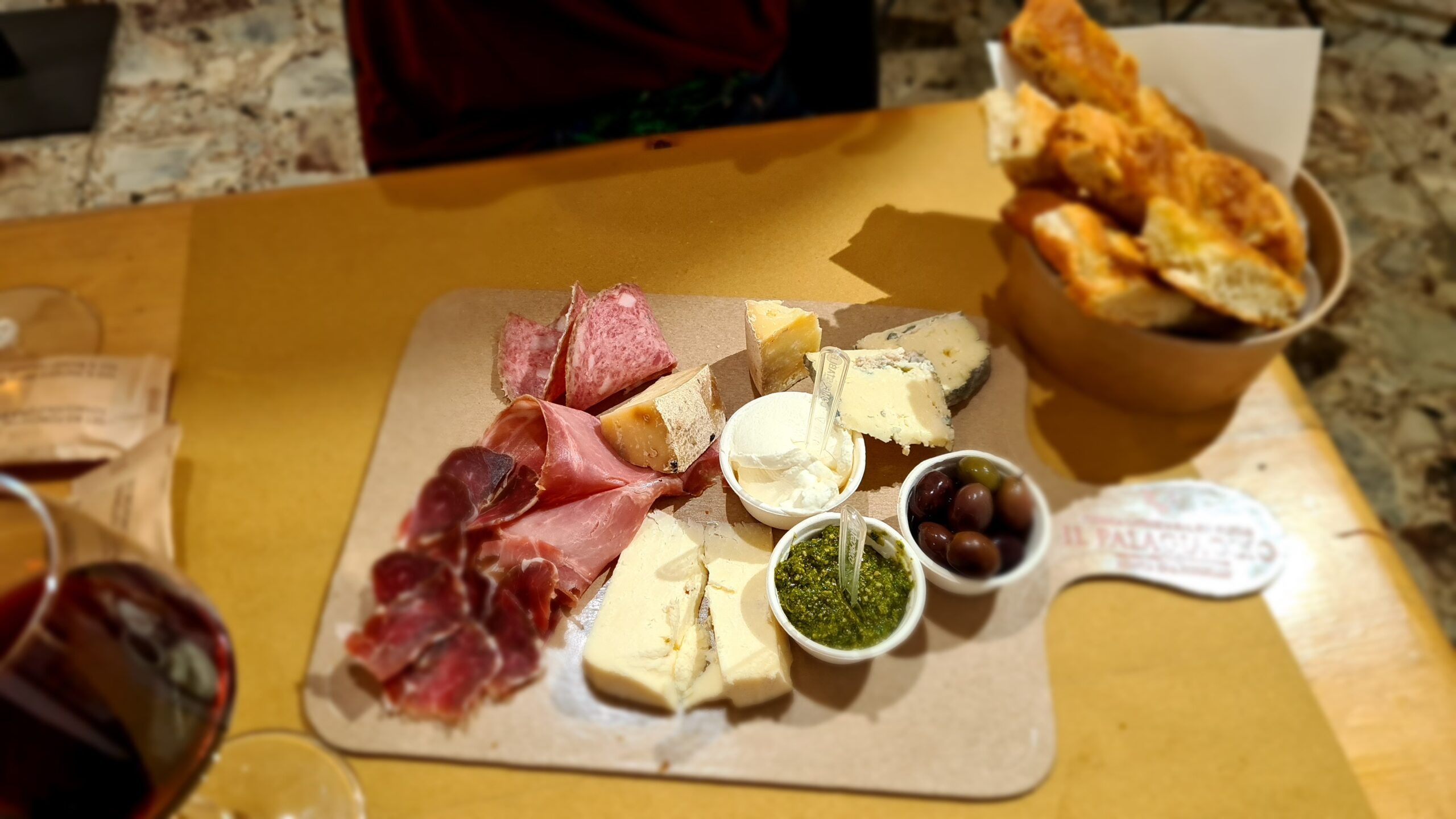
We end up talking to Giampiero for over an hour, fortunately for us, it’s not a busy day. The conversation meanders from our travels, to the quality of ingredients, to past lives, leaving careers behind and how Italians are born problem solvers due to nothing working as it should in the country, Giampiero is both interesting and interested. Passionate about the produce in his shop and thankful of speaking to two such lovely people as ourselves, he gives us a couple of extra little morsels to try. What a treat.
After three glasses of wine and a feast of good produce, it’s time to say farewell, but not before Little Boof insists on photos of us all together and we exchange instagram handles (Ciao Giampiero).
We don’t know if the other stores are as well run, but if you’re in Florence and in the Via Nazionale area, we highly suggest giving Giampiero a visit at Il Palagiaccio (#this-is-not-an-advert). In looking up the store details to ensure I got the spelling correct, I’ve seen some excellent Google reviews for their focaccia sandwiches, I want to go back already!

As we’re almost at our planned destination we take a short walk to the Social Hub, where they have a rooftop bar with a view across Florence. Or at least, they’re supposed to. Sods law, it’s closed.
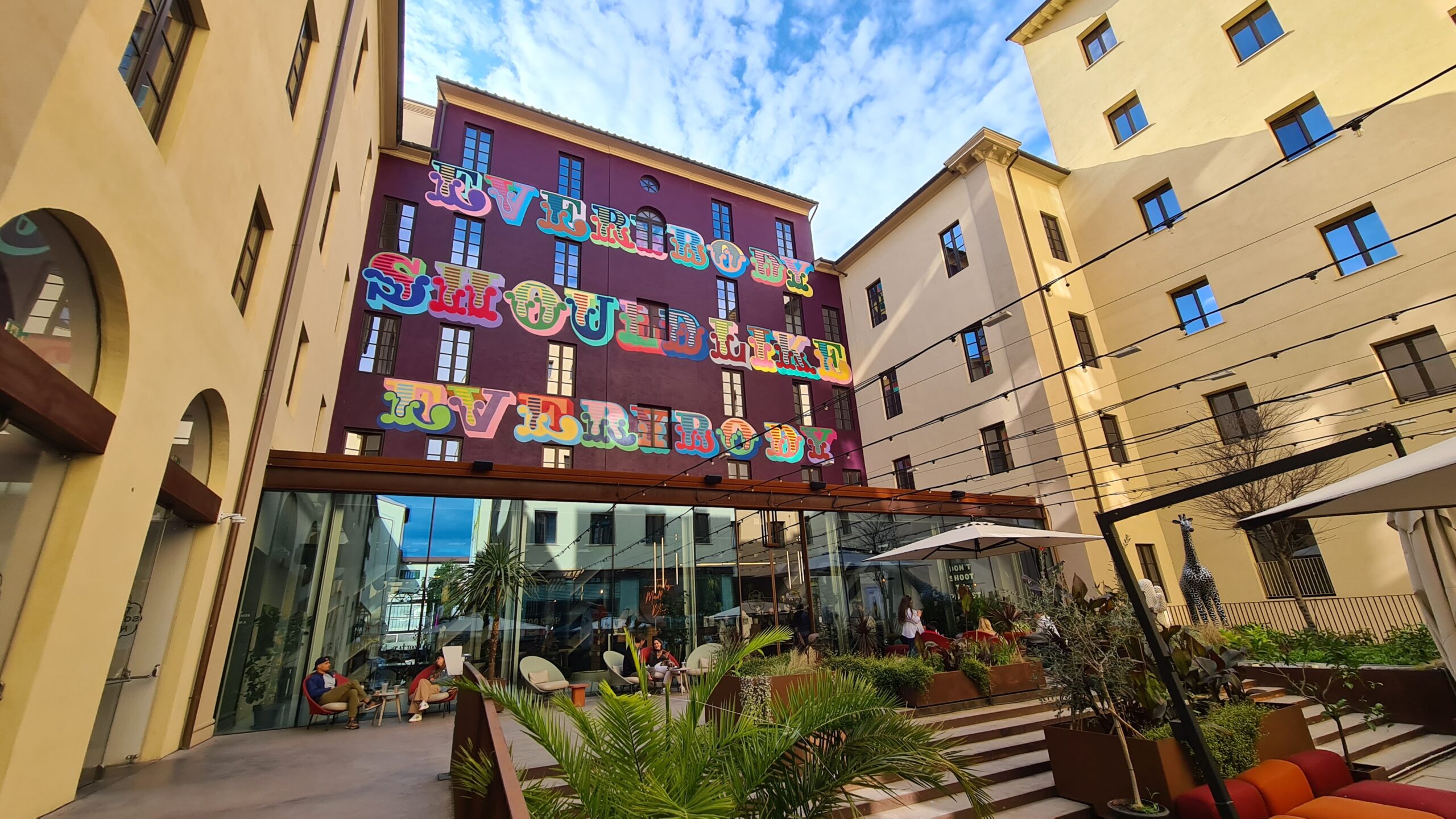
 The vibe is good, if a bit hippyish, “everybody should love everybody” adorns the interior courtyard of the building. It’s a hotel/hostel, co-working space with table tennis table, coffee shop, bar, lounge, circus type place. You know the sort of place where you hear a conversation about making a startup profitable? Well that’s exactly what we heard.
The vibe is good, if a bit hippyish, “everybody should love everybody” adorns the interior courtyard of the building. It’s a hotel/hostel, co-working space with table tennis table, coffee shop, bar, lounge, circus type place. You know the sort of place where you hear a conversation about making a startup profitable? Well that’s exactly what we heard.
But for us, with the bar shut and the rest of Florence to explore we leave the entrepreneurs, bohemians and table tennis enthusiasts to it. But not before we had a go on their swings in reception (“never forget to play”).
Still without a rooftop drink in hand, we kept wandering—Florence had more in store.
Like Venice, I think you get a lot just from wandering the streets of Florence, the beauty of the architecture, the buzz of the tourists and locals, stumbling upon a nice shop, bar or restaurant. It’s the best way.
We wandered back towards the Cathedral, Basilica di Santa Maria del Fiore, while we briefly saw it in the morning we wanted to take a better look. However, the queues were a bit mad and therefore we were only able to admire its majesty from the outside. Giotti’s tower, Brunelleschi’s famous red tiled dome, the neo-Gothic facade, marbled walls, the fourth largest church in the world, are quite breathtaking.

As we walked away we saw a sign for a rooftop bar, hello Hotel Villani! A very unassuming entrance next to an Enoteca on Via dell’Oche, very easy to miss. You take a lift to the 4th floor and head up a small set of stairs with only room for one person. A nicely furbished bar leads out to a roof terrace that looks at the Cathedral, winner! The service is typically slow and the wine quite average, but we get snacks and the view of the Cathedral is fantastic.
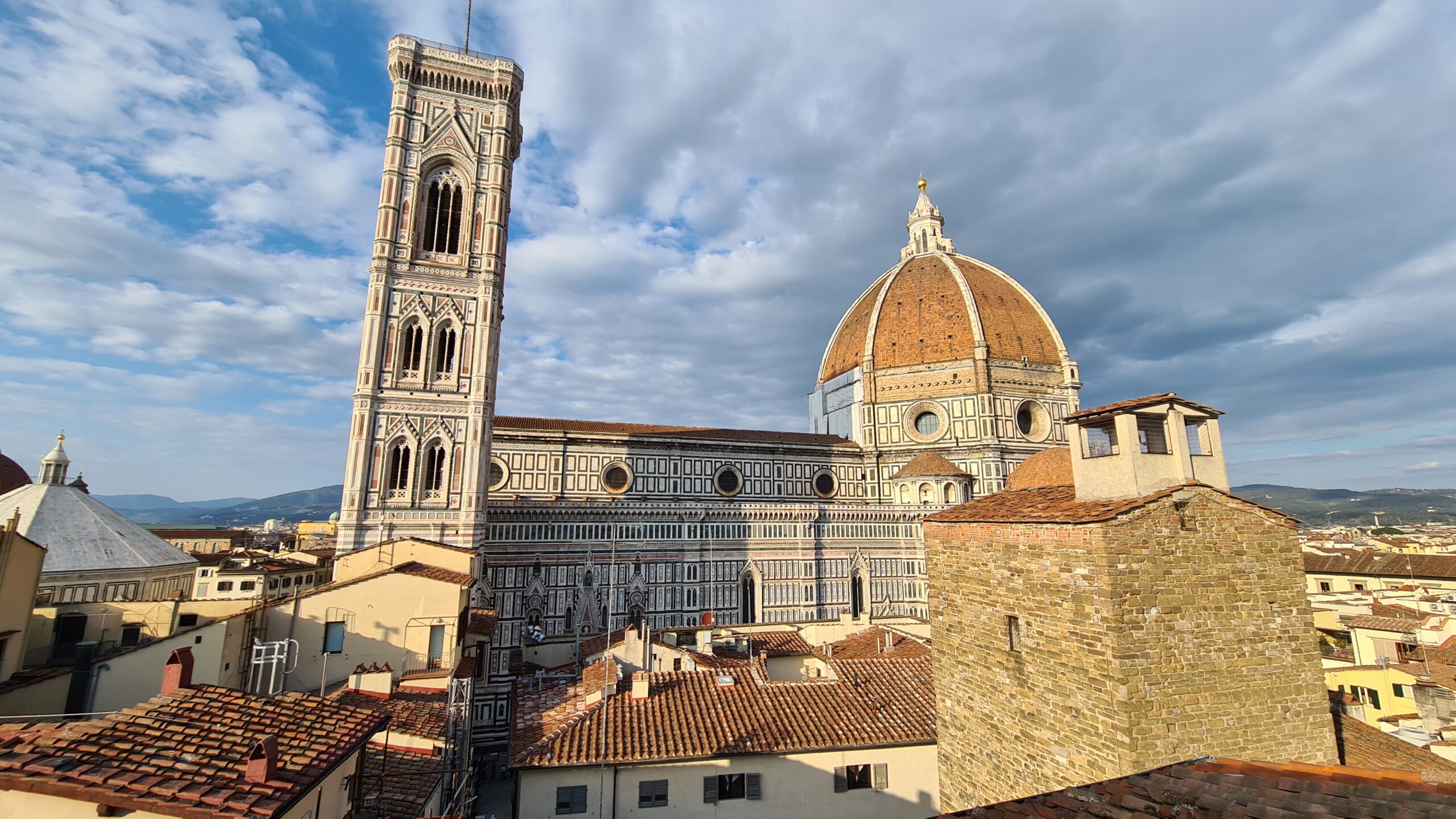
With the light fading all we needed was a little serenading from the bells. Right on cue they strike up, how’s our luck?!
While the view of the Cathedral is fantastic, we’ve booked a pasta making course we’re very excited for. On our way, we’re lucky enough to realise the walk to the restaurant takes us to the Arno just as the sun is finally setting. From our viewpoint the sun sets behind the impressive dome of Chiesa di San Frediano in Cestello. The bridges and river are lined with other lucky sunset worshippers.
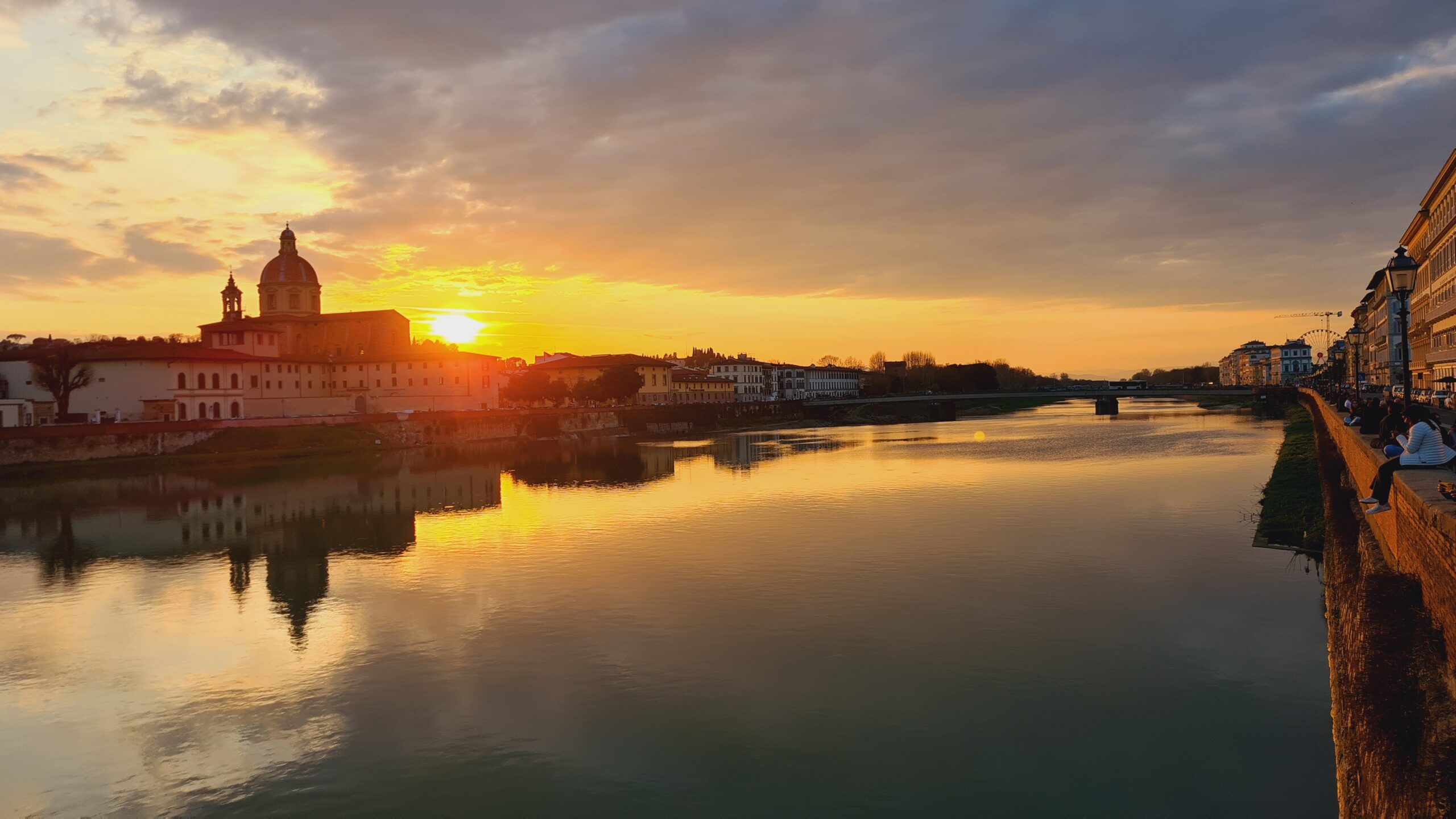
Piazzale Michelangelo is apparently the best place to watch sunset in Florence, but if you can’t make it there and want to stay more central, the river is a great option.

From the river we head to De Bardi restaurant for our pasta making course with Chef Antonio.
The venue has three different areas to split the numbers into three classes each with your own chef leading you through the magic. Three different types of pasta and learning how to make a ragu Florentine style (or at least Antonio style).
Disclaimer: The details of this description of our night may get progressively scarce/made up – with the pasta making instruction came as much wine as you like, something I took full advantage of.
We start with the ragu, the pasta making takes is hours, it will need a good 90 minutes to cook down properly. We gather round as Antonio explains in what order everything should go. First the soffritto mix in a generous amount of olive oil, then very quickly the beef (he explains some mix their mince meat, he uses 100% beef). We’re both amazed at how little time he cooks the veg before adding the meat, and before we know it he adds the herbs, sage, bay and rosemary. Generous amount of wine, red in this instance but he said either will do, and then let the meat absorb the flavours. Finally, he adds San Marzano tomatoes, but not too much of the juice, the tomatoes are there to add some tomatoey sweetness not to take over the dish.

There are many variations on ragu depending on the region, some prefer red wine over white, some don’t use tomato at all, others use milk etc, but what we note is that there’s not really the detailed process like French cooking, get all the ingredients in, let time do the magic and the quality of the ingredients speak for themselves.
Then it was straight into making pasta dough – two eggs, 40g semolina and 120g durum flour. No machines, all by hand with the assistance of a pasta scraper and rolling pin, much to Zoe’s relief as she doesn’t have fond memories of trying a pasta machine. Work the pasta, adding more semolina, apparently you can’t overdo the semolina, once the dough becomes smooth and bouncy it’s time to rest it in clingfilm.

Then we make a very simple filling, for two of our pastas are going to be filled, one a type of tortellini shape and the other a classic ravioli. For the filling it’s very simply ricotta cheese, lemon rind, and a bit of pepper/olive oil, mix it to your taste.
 To be honest, I’m not 100% sure what the pasta shape is that we made first, we thought it might be tortellini but having looked into it further maybe it was cappelletti, or maybe it was Antonio’s own invention sparing us from making anything too intricate. First we rolled out one third of our pasta dough, basically to as thin as we dared ensuring there was enough pasta for three squares. A little filling, a little water on two sides, one corner over to the other, squeeze around the filling, trim the excess, bring two corners together… simples! For once I was actually working faster than Zoe in the kitchen, perhaps my little baking experience was paying off.
To be honest, I’m not 100% sure what the pasta shape is that we made first, we thought it might be tortellini but having looked into it further maybe it was cappelletti, or maybe it was Antonio’s own invention sparing us from making anything too intricate. First we rolled out one third of our pasta dough, basically to as thin as we dared ensuring there was enough pasta for three squares. A little filling, a little water on two sides, one corner over to the other, squeeze around the filling, trim the excess, bring two corners together… simples! For once I was actually working faster than Zoe in the kitchen, perhaps my little baking experience was paying off.
Zoe and I, quite proud of the uniformity of our shapes and tidy work, realise we’re virtually natives compared to the carnage others have turned out. Seriously, some people would’ve been chased out the kitchen by nonna with a rolling pin.
 We’re onto a simple ravioli. Similarly rolled the pasta out, a little wider this time to allow us to fold it over the filling. Four blobs of filling water along the long edge and between fillings, fold, press, trim with pasta cutter, job done, easy! Mine were cut and awaiting Antonio’s approval before Zoe had even finished her filling, maybe there’s a future in this for me?!
We’re onto a simple ravioli. Similarly rolled the pasta out, a little wider this time to allow us to fold it over the filling. Four blobs of filling water along the long edge and between fillings, fold, press, trim with pasta cutter, job done, easy! Mine were cut and awaiting Antonio’s approval before Zoe had even finished her filling, maybe there’s a future in this for me?!
The final pasta was pappardelle, basically wide tagliatelle, the pasta that will be used for the ragu sauce and it couldn’t be simpler. Roll out long and thin, fold up, cut into 2-3cm wide strips, unfurl with a bit of semolina to stop them sticking.

Top tip from Antonio, you can use the pasta trimmings, chopped up, in a soup such as a minestrone.
With the pasta all made, we got to eat it of course. The two filled pasta dishes are served with a sort of sage butter emulsion. One of the issues as we saw previously, was different people’s aptitude was a little different and because all the pasta was chucked in together you don’t necessarily get to eat your own. Overly thick, filling without flavour, barely any filling etc. It will fill you up and you’ll have fun, but don’t go expecting a gourmet meal at the end of it.

And the ragu? The ragu itself was delicious, but I had a couple of bits of very thick rubbery pasta, I can only assume the individual making this gave up on the rolling after too much free wine. It leads to some laughter and conversation with Gabby and Chris opposite us. Gabby is a talented artist from the U.S. who just finished an exhibition and Chris was taking some well earned annual leave to join his fiance before she took her exhibition onto the next stop. A couple of lovely people, a pleasure to enjoy their company over some badly made pasta and lovely sauce.
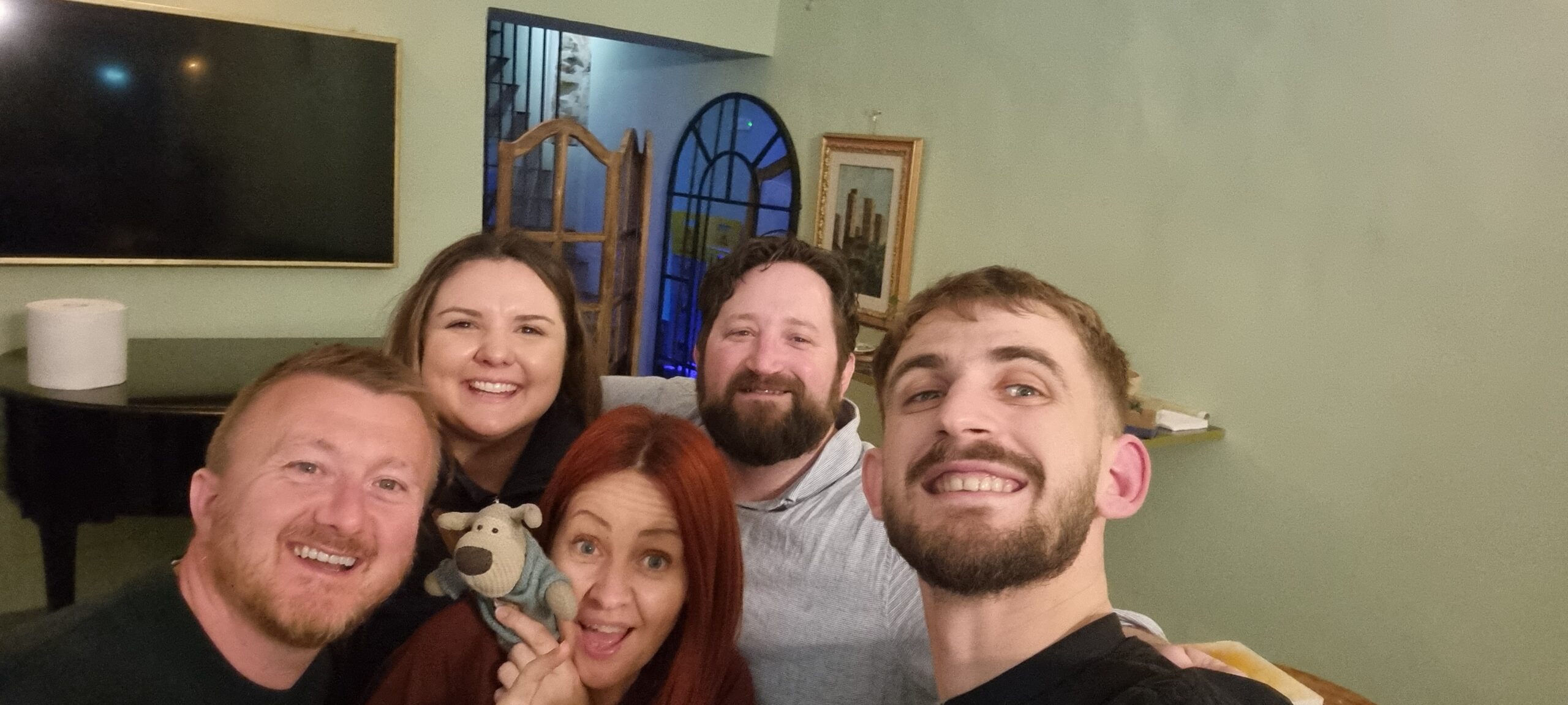
All in all, we had a lot of fun and homemade pasta will definitely be making its way to our dining table again.
Check out their instagram here.
With full bellies and fuller hearts, we headed back to the station.
It’s been a long day, and unfortunately due to poor phone battery management and a malfunction that meant the battery pack had been used, we’re down to running on fumes. We just about manage to find our way to the station to catch the last train back to Prato.
What a day!
Can you do Florence in a day? … No, of course not.
Can you have fun in Florence in only a day? … 100%, yes.
***********
Edit: We sit here having written this blog not long after hearing of the torrential rain and flooding that has hit Tuscany after we left. We hope everyone is ok, and that damage is minimal. A train strike was extremely trivial in comparison to what they have had to deal with since!
***********
Follow us on instagram @a2z.wander

A2Z Wander | Our Blog A Rainy Arrival (and a Slight Hangover) Lamezia Terme almost didn’t get its own blog post. There’s only so many
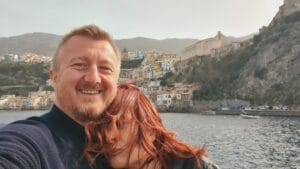
A2Z Wander | Our Blog A short coastal train ride punctuated by dramatic thunderclaps brought us further down into Calabria to a town called Scilla.
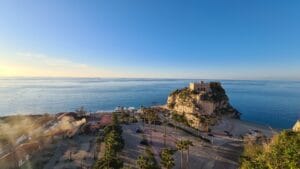
A2Z Wander | Our Blog This is quite the introduction to the town of Tropea… This is the view from Belvedere Piazza del Cannone in
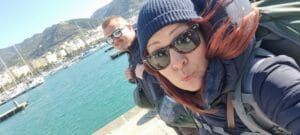
A2Z Wander | Our Blog Three weeks into the trip, and we were finally swapping wheels for waves, boarding our first boat along the coast
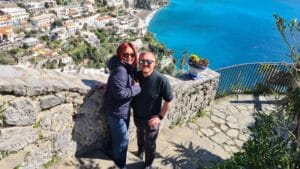
A2Z Wander | Our Blog With Sorrento in our rear-view mirror and the sea glittering to our right, we eased into the Amalfi Coast Drive,

A2Z Wander | Our Blog Naples left its indelible mark on us. We were sad to be leaving with so much still unexplored. But, if